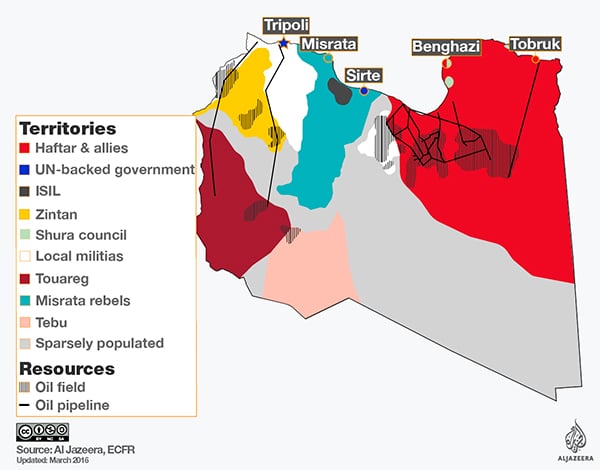
Political instability and a lack of a unified national security force have made Libya the perfect breeding ground for jihadism to develop and expand. Groups like ISIS and al-Qaeda associate Ansar al Sharia in Libya (ASL) exploit the weakness of the internationally-backed Government of National Accord (GNA) to establish themselves within Libya, in addition to using their Libyan cells to coordinate attacks in the region and even contribute to some in Europe. The fall of ISIS’s former stronghold of Sirte in December 2016 severely debilitated ISIS in Libya, and the group is currently trying to rebuild its capabilities by appealing to marginalized sectors of the population and conducting small-scale attacks. Meanwhile, ASL is degraded by the advances of the Libyan National Army (LNA), led by military strongman Khalifa Haftar, which has attacked ASL-aligned Islamist coalitions in cities like Benghazi, Derna and Jufra. Despite ISIS’s deteriorated conditions and the LNA’s military gains against ASL, Libya will continue to provide the optimal conditions for the growth of Islamist radicalism until the political and military situation in the country has been stabilized.
Libya was considered a hub for ISIS activity outside of the Levant, as the city of Sirte was the first ISIS “caliphate” established outside of Syria and Iraq. Sirte was also a convenient passage for recruits coming from all parts of Africa, who wanted access to the Mediterranean in order to join ISIS in its main territories of Syria and Iraq. The downfall of Sirte, therefore, not only diminished ISIS’s cells in Libya, but gravely damaged the global narrative of the expansion of the so-called Islamic state. A coalition of Islamist militias from the city of Misrata, some of which are aligned with the GNA, took back control of Sirte in December 2016, with support from US airstrikes. This victory was a stepping stone in the dismantling of the global ISIS caliphate, and a decisive step in the process to oust ISIS from Libya.
Since the fall of Sirte, ISIS has been conducting a series of small-scale attacks against water infrastructure, in an effort to disrupt the flow of water to big cities and increase the tensions between the groups fighting for control. None of these have contributed significantly to the global or the Libyan ISIS campaign. ISIS, however, continues to try to rebuild its presence in and around Sirte, even conducting its first attack since the fall of Sirte on GNA-aligned forces in early May. ISIS will exploit the heightened conflict in southwestern Libya, where forces aligned with both the LNA and the GNA competed for control over infrastructure over the past few months, to conduct attacks where security may have been decreased. At the same time, as seen in the ISIS-claimed attack in Manchester on May 22, ISIS will continue to take advantage of Libya’s instability to recruit foreign fighters. Reliable Libyan security and intelligence mechanisms, combined with strict cooperation with European and international security forces, would be essential to stop attacks in European soil at the root of the problem.
As previously mentioned, al-Qaeda has also had a strong presence in Libya through its Libya-based group Ansar al Sharia in Libya (ASL). Despite ASL’s recent declaration of its dissolution, Salafi-jihadism is far from eradicated in Libya. ASL’s capabilities were increasingly debilitated before its dissolution, due to the Libyan National Army (LNA)’s campaign against several Islamist coalitions of which ASL is a part of. In Benghazi, the LNA is wrapping up its fight for control of the city against the Benghazi Revolutionaries Shura Council (BRSC), whereas in Derna, the LNA is battling the Mujahideen Shura Council of Derna (MSCD). The Benghazi Defense Brigades (BDB), an offshoot of the BRSC, was recently defeated in its fight against the LNA for control over territory and resources in Jufra, central Libya, and in Sebha, southwestern Libya, where it was aligned with Misratan-led forces. ASL was a part of each of these militia coalitions, and although the LNA made significant advances against each of these groups, ASL’s efforts to adapt al-Qaeda’s global narrative to the local needs of different cities in Libya has provided it with a wide support network that will remain despite its dismantling and its increasing loss of control over territory.
ASL has been significantly more active than ISIS in Libya in the past few months, as its cells are currently stronger and are established in several different Libyan cities. The LNA’s fight to regain control of Benghazi from the BRSC is coming to an end after months of fighting, with only a few districts remaining under militant control. The BRSC is likely to escalate its insurgency in LNA-controlled areas even after Benghazi falls under LNA control. It is also likely to increase its attacks against the LNA in Derna and Ajdabiya, both in eastern Libya, as fighters ousted from Benghazi flee to east and south of the city. Meanwhile, the BDB has been actively fighting the LNA in Jufra, central Libya, and in Sebha, southwestern Libya, joining the Islamist Misratan Third Force and the forces from the GNA Ministry of Defense (which often acts independently from the GNA) in a (now failed) effort to halt the LNA’s expansion into western Libya and its control over oil infrastructure and several airbases. ASL, therefore, continues to pose a threat to western interests in Libya, despite its recent defeats in several parts of the country.
Governing entities trying to eradicate the widespread problem of Salafi-jihadism in Libya will be faced with several challenges. The only internationally recognized governing body in Libya, the GNA, is widely opposed by other military and political bodies, and is extremely internally fractured. This makes it difficult for the political process to advance, fostering conditions of instability that make the fight against Salafi-jihadism a disorganized and uncoordinated effort. Unity between a UN-backed government and the most powerful Libyan military entity, the LNA, will be the first step to jumpstart the process that will provide a permanent, long-term solution to end the Libyan crisis and effectively end terrorism, as well as create conditions that will incapacitate radical Islamist groups from re-emerging.

